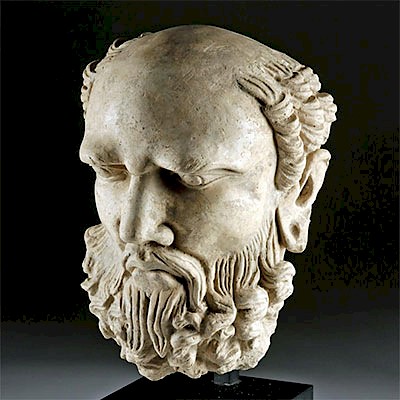Exhibited 19th C. Russian Icon Christ Pantocrator, Kiot
Lot 336
About Seller
Artemis Fine Arts
686 S Taylor Ave, Ste 106
Louisville, CO 80027
United States
Selling antiquities, ancient and ethnographic art online since 1993, Artemis Gallery specializes in Classical Antiquities (Egyptian, Greek, Roman, Near Eastern), Asian, Pre-Columbian, African / Tribal / Oceanographic art. Our extensive inventory includes pottery, stone, metal, wood, glass and textil...Read more
Categories
Estimate:
$4,500 - $6,750
Absentee vs Live bid
Two ways to bid:
- Leave a max absentee bid and the platform will bid on your behalf up to your maximum bid during the live auction.
- Bid live during the auction and your bids will be submitted real-time to the auctioneer.
Bid Increments
| Price | Bid Increment |
|---|---|
| $0 | $25 |
| $300 | $50 |
| $1,000 | $100 |
| $2,000 | $250 |
| $5,000 | $500 |
| $10,000 | $1,000 |
| $20,000 | $2,500 |
| $50,000 | $5,000 |
| $100,000 | $10,000 |
| $200,000 | $20,000 |
About Auction
By Artemis Fine Arts
Jan 16, 2020
Set Reminder
2020-01-16 10:00:00
2020-01-16 10:00:00
America/New_York
Bidsquare
Bidsquare : Ancient | Asian | Ethnographic
https://www.bidsquare.com/auctions/artemis-gallery/ancient-asian-ethnographic-4799
Featuring classical antiquities, ancient and ethnographic art from cultures encompassing the globe. Artemis Fine Arts info@artemisfinearts.com
Featuring classical antiquities, ancient and ethnographic art from cultures encompassing the globe. Artemis Fine Arts info@artemisfinearts.com
- Lot Description
Russia, ca. 19th century CE. Finely painted in egg tempera, gold leaf and enamel, an icon of Christ Pantokrator, Lord of the Universe, holding an orb symbolizing the universe rather than a holy Gospel in his left hand, the fingers of his right hand giving benediction, arranged to form the initials of Christ’s monogram, IC XC. The icon is set in a decorative glass-fronted wood kiot of a fanciful shape with an ornately carved and gilded liner of high relief grapevines dripping with clusters of the fruit of the vine. Size: 22.75" W x 26.75" H (57.8 cm x 67.9 cm)
The most accepted translation of Pantocrator is "Almighty" or "All Powerful" and the visage of Jesus certainly projects his omnipotence. This iconic depiction continues to be a central icon of the Eastern Orthodox Church. Christ gazes beyond the confines of the image, his visage finely delineated with graceful brushstrokes, a rendering aspiring to the naturalism sought in classical antiquity and the Renaissance, this in contrast to the large and relatively flat gilded nimbus and surrounding decorated arch and corners – resulting in a rich balance between naturalism and spiritual transfiguration.
The wood kiot is a case that protects the icon from smoke and dust as well as temperature and humidity variations to some extent; however, it also serves to enhance and add ornament to the icon. This example in particular with its decorative shape and ornate carved and gilded liner bestows the icon with glorious splendor.
Exhibited in "Windows Into Heaven: Russian Icons from the Lilly and Francis Robicsek Collection of Religious Art" at the Mint Museum of Art, Charlotte, North Carolina (December 20, 2003 through February 22, 2004) which presented highlights of one of the world's great artistic traditions through an extraordinary group of sixty-five 18th and 19th century Russian icons on loan from the private collection of Lilly and Francis Robicsek.
Icons (icon means "image" in Greek) are sacred objects within the Eastern Orthodox Christian tradition. Found in homes as well as churches, these painted images depict holy persons and saints as well as illustrate scenes from the Scriptures. Some icons are encased in precious metal covers (oklads) adorned with pearls and semi-precious stones or glass-fronted wooden cases (kiots) like this example which is further embellished by the ornate gilt liner. Icons are not worshiped, but are instead venerated for their ability to focus the power of an individual's prayer to God. As such they are truly "windows into heaven."
The “Windows Into Heaven” exhibition profiled a magnificent chapter of Russian artistry, the embrace of the Russian Orthodox faith of religious icons during the Romanov centuries. The Russian religious faith was an offshoot of Byzantine Christianity, which in 1054 parted ways from Roman Catholicism. Icons were and continue to be religious images created for veneration. As a focus for prayers and meditation for believers, icons serve as “windows into heaven.”
Provenance: private Francis & Lilly Robicsek Collection, Charlotte, North Carolina, USA, acquired second half of the 20th century; exhibited at Mint Museum of Art "Windows Into Heaven", Charlotte, North Carolina (December 20, 2003 through February 22, 2004)
All items legal to buy/sell under U.S. Statute covering cultural patrimony Code 2600, CHAPTER 14, and are guaranteed to be as described or your money back.
A Certificate of Authenticity will accompany all winning bids.
We ship worldwide and handle all shipping in-house for your convenience.
#119621Surface losses to pigment and gold leaf. Some stable cracks and losses to gilded insert. Losses and fissures to back of kiot as shown.Condition
- Shipping Info
-
All shipping is handled in-house for your convenience. Your invoice from Artemis Gallery will include shipping calculation instructions. If in doubt, please inquire BEFORE bidding for estimated shipping costs for individual items.
-
- Buyer's Premium



 EUR
EUR CAD
CAD AUD
AUD GBP
GBP MXN
MXN HKD
HKD CNY
CNY MYR
MYR SEK
SEK SGD
SGD CHF
CHF THB
THB




















